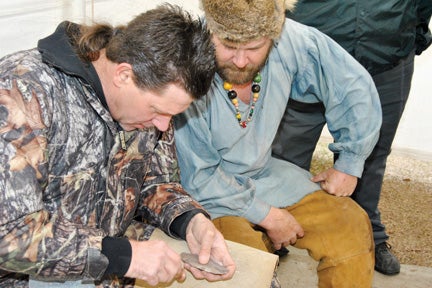Knapping the afternoon away
Published 12:17 pm Thursday, March 7, 2013

Stan Payne of Slapout who started the Knap-In demonstrates his skill as Bubba Wills of Lake Berry Road in Lowndes County looks on.
By Fred Guarino
The Lowndes Signal
Flint knappers from near and far gathered to hone their skills in making stone arrowheads, projectile points and stone tools, as well as to show off their wares, including animal hides and carved deer antlers at Southern Sportsman Lodge off U.S. 80 near White Hall in Lowndes County this past weekend.
The event was the Fifth Annual Flint Stone and Bone Creations Knap-In and Primitive Crafts Event, held March 1-3.
Some participants even spent the nights in teepees with a warm fire inside cooking venison (deer meat) bologna.
According to Webster’s New College Dictionary, knap or knapping means to break or chip flints with sharp blows.
Bill Skinner of Marengo County has been knapping for 10 years.
While most people are familiar with the process used by Indians to make arrowheads and spear points, “This is not just Indians. This is a people thing,” Skinner said.
Skinner said he uses a copper tool and antler to work his points. Saturday, he was making a stone knife.
“A lot of people see this… think this is something the Indians did, they sort of don’t seem to understand that everybody’s ancestors did this at one time,” he said.
Stan Payne of Flint Stone-N-Bone Creations of Slapout has been heading up the knap-in, which he started, for five years. He’s been knapping for 19 years.
He said flint knappers and artifact collectors come to the event.
According to Payne, the knappers look at the artifact to learn to replicate them.
He said this is accomplished by “checking the flake scar patterns, if its random, percussion or if it’s parallel flakes. So many artifacts were made so many different ways and that’s how we learn to make them,” Payne said.
Bubba Wills of Lake Berry Road said he tans hides the same way the Indians have done it for thousands of years. He also does trap lines and catches the animals for his hides.
“I don’t knap points. What I do is I more or less knap tools that I use to flesh all my hides with because all my hides are all done by stone tools.” Wills said.
Danny Hendrix of Notasulga was there showing off his carved deer antler horns.
While he also knaps, he said he carves his antlers with a handheld electric drill.
William Arthur of Burkville also does animal hides and traps. He and Wills stayed in a teepee where they showed off the different stages of what they do.
Wills had a couple of otter skins that had been dried and salted with a little work left to do to turn them into usable hides.
Arthur explained that the traps used are leg holds that don’t injure the animals.
“In the fur industry, you don’t want any cuts on it. These traps are designed to hold them (the animals), not designed to hurt,” he said.
“Being Lowndes County is a big deer hunting place, a lot of people are interested in predator control and this is right here is the most efficient way you can control your predators is by trapping,” he said. “You can only hunt and call them so much and they get weary and leave. With trapping you’re always able to catch that next animal. “
Arthur demonstrated the humane nature of the traps that he said have to be checked every 24-hours by allowing one to snap on his own hand without injuring him.





